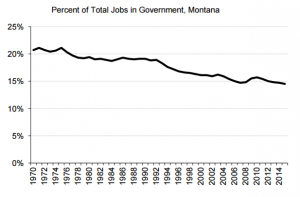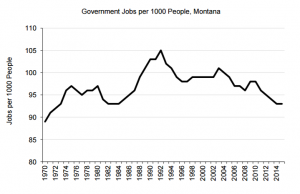The size and scope of government is a common political football that gets kicked around on a regular basis. There are many angles and contexts in which to examine this topic. Facts are often hard to come by which allows debaters on both sides of an issue to claim at least some success and thus be re-energized to participate in a future rehashing of the topic.
A Bozeman based company (Headwaters Economics) has created a very handy tool, the Economic Profile System. This tool easily generates a free report that shows trends in government employment (federal, military, and state & local) since 1970 for a county or state. As with any good collection of data there is a little something for everyone in the reports.
Montana had about 660,000 employed workers in 2015 and 14.5% of these workers were employed by the government. The national average for government employment is 12.7%. In Montana, the federal government employs 2% of workers, the military another 1.2% and state & local governments an additional 11.3%. The percentage of total jobs in Montana that are government jobs has declined steadily since 1970 when just over 20% of all jobs were government jobs.

Employment in the government sector has grown 54% since 1970. Employment by the federal government is up 8%, state & local government employment is up 92% while military employment has decreased 31%. Over the same period, private non-government employment grew 137%.


Montana’s population has increased from less than 700,000 in 1970 to over a million today. One way to examine the data to address the population growth is to look at how many government jobs are in Montana per 1,000 residents. The chart below shows that in 1970 this ratio was about 88 jobs per 1,000 residents, this ratio increased substantially from 1984 to 1992 when it peaked at 105 jobs per 1,000 residents. Since 1992, this ratio has declined to a rate of about 93 jobs per 1,000 residents.

These figures hopefully added some facts to the discussion about the role of government employment in the Montana economy. The reports generated by the Economic Profile System also contain considerably more information if you are interested. You can generate a report for your county or compare your county to another county or the state average. I doubt this information will substantially swing the size and scope of government debate in any direction but it might add some facts to the discussion.

